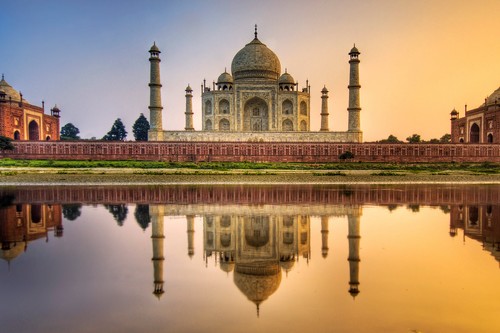The symbole of Love, Taj Mahal is a white marble tomb situated in Agra, Uttar Pradesh, India. The Taj Mahal represents itself with no issue. It is really a marvel and the best landmarks ever built. The hues and development is completely dazzling. It was worked by Mughal sovereign Shah Jahan in memory of his third spouse, Mumtaz Mahal. The Taj Mahal is generally perceived as "the gem of Muslim workmanship in India and one of the all around respected artful culminations of the world's legacy".
Shah Jahan and
Mumtaz Mahal
Mughal Emperor
Shah Jahan had the Taj Mahal worked in memory of his third spouse Mumtaz Mahal
whom he held valuable. Mumtaz Mahal was bringing forth the fourteenth offspring
of the head, and she passed on simultaneously. This was in 1631. Legend has it
that Shah Jahan, who considered his sovereign an indispensable piece of his
life, was broken after her passing, and inside only a couple of months, his
hair and facial hair developed snow white, such was the horrible effect of the
destruction upon him.
Time and amount
The
development of the Taj Mahal was started in 1632, a year after the demise of
Empress Mumtaz. The development was finished in the year 1653, which implies
that it took around 22 years to finish this bewildering bit of engineering.
Around then, the evaluated development expense was an astounding whole of Rs.
32 million, which, when considered as far as today's estimation of cash, would
be something path above $1 billion.
Construction
and Employees
The engineer
behind all the enchantment was Ahmed Lahauri. He put more than 20,000
individuals into building the Taj, including workers, stonecutters, painters,
weaving specialists, calligraphers, and numerous others. Be that as it may, how
were the stones and materials required for the development of the sepulcher
transported? Indeed, elephants were utilized to do the errand, and amazingly,
there were more than 1,000 of the magnificent animals utilized.
Materials Used
The sublime
structure is limited on three sides by red stone dividers. It is built totally
of white marble. The ruler had marbles of the best quality brought from
Rajasthan, Afghanistan, Tibet and China. Be that as it may, this was presumably
insufficient for the head. It is trusted that more than 28 unique sorts of
valuable and semi-valuable stones, including the striking lapis lazuli, were
decorated into the marble. Presently we know where all the cash went.
Inscriptions
The Taj Mahal
being the devotion and respect of Mumtaz Mahal, it has calligraphy everywhere
throughout the inside and outside, which, among different examples and blessed
engravings, additionally has calligraphy on the tomb that distinguishes and
acclaims Mumtaz Mahal. Another intriguing reality is that there are 99 names of
Allah found on the sides of the genuine tomb as calligraphic engravings. All
things considered, Shah Jahan envisioned Mumtaz's home in the heaven, and Taj
Mahal was that creative ability becoming animated.
The Perfection
that Taj Mahal Is
The Taj Mahal
is one of the world's most symmetrical structures. Its four sides are superbly
indistinguishable, assembled utilizing the standards of self-replication and
symmetry in geometry and design, in this manner making a reflected picture on
either side. Be that as it may, to keep the male tomb bigger than the female,
the two tombs inside are unequal in size. The four minarets were wisely
constructed somewhat outside of the plinth, so that in the event that they
fell, they would fall outside, and not upon the primary structure.
Changing Moods
of the Taj Mahal
Did you
realize that the Taj Mahal measurement diverse hues at various times of the
day? The white marble and the intelligent tiles help the Taj change hues. In
the early morning, it expect a modest pinkish tone, which swings to a sparkling
white as the day moves on, and turns a polished brilliant around evening time
in the moonlight. The Taj Mahal is a specific fascination when on full moon
evenings. The changing hues are said to be practically equivalent to the
inclinations of a lady – Mumtaz Mahal, to be particular.








0 comments:
Post a Comment